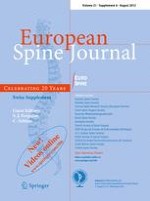Published in:

01-08-2012 | Review Article
Predictive value of the Acute Low Back Pain Screening Questionnaire and the Örebro Musculoskeletal Pain Screening Questionnaire for persisting problems
Authors:
Martin Sattelmayer, Tobias Lorenz, Christoph Röder, Roger Hilfiker
Published in:
European Spine Journal
|
Special Issue 6/2012
Login to get access
Abstract
Introduction
A small proportion of individuals with non-specific low back pain (NSLBP) develop persistent problems. Up to 80% of the total costs for NSLBP are owing to chronic NSLBP. Psychosocial factors have been described to be important in the transition from acute to chronic NSLBP. Guidelines recommend the use of the Acute Low Back Pain Screening Questionnaire (ALBPSQ) and the Örebro Musculoskeletal Pain Screening Questionnaire (ÖMPSQ) to identify individuals at risk of developing persistent problems, such as long-term absence of work, persistent restriction in function or persistent pain. These instruments can be used with a cutoff value, where patients with values above the threshold are further assessed with a more comprehensive examination.
Methods
We systematically reviewed studies evaluating the accuracy of the ALBPSQ and ÖMPSQ to predict persistent problems.
Results
The 13 included studies used different cutoff values for the screening questionnaires ranging from 68 to 147. The pooled sensitivity was 0.59 (0.43–0.74), while the pooled specificity was 0.77 (0.66–0.86). Heterogeneity (I
2) was 90.02% for sensitivity and 95.41% for specificity.
Conclusion
Thus, we do not recommend the use of one cutoff value, but the use of a prediction model with all the individual items.





